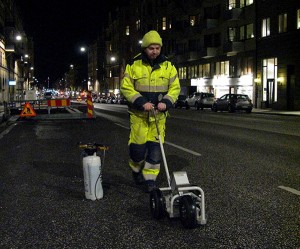The concentrations of inhalable particulate matter (PM10) in the air in several Swedish cities do not meet the EU air quality directive and the Swedish Environmental Quality Standards. Since 2011, intensifying efforts are made to reduce particle levels in Stockholm, where the problems are extensive.
The first two seasons, a few streets were used as pilot sites for the various measures where the resulting PM10 levels were compared with levels in streets where no special PM10 abatement efforts were made. Additional cleaning efforts with advanced cleaning machines in combination with dust binding with CMA (calcium magnesium acetate) have been evaluated. Mainly dust binding has been shown to give good results.
The current season the trials were extended to full scale, with 35 streets cleaned with a cleaning machine, using only high vacuum, and dust is bound with CMA throughout winter and spring. On the Sveavägen street, which has two PM10 measurement stations, the concentration variations could be tested and evaluated. Two special methods were tested: block-wise CMA treatment and treatment with CMA mixed with potassium formate (KF), which has proven to increase the duration of the dust binding in laboratory studies. Since no reference streets remain, the evaluation of the abatement methods could not be made pair-wise (test street / reference street) as before.
The lowest PM10 levels since records began in Stockholm were measured during the season and the limit values for the environmental quality standard is managed by a wide margin, which at least partially can be attributed to the intensified measures. The winter was unusually mild and snow-free and this has probably contributed to that, the typically large quantities of road dust that accumulates on the road surface in winter were able to leave the system through suspension, cleaning and drainage without high particulate levels resulting. During dry periods, frequent dust binding has helped to suppress high PM10 levels. The usually sharp PM10 peak in spring did not appear to the same extent as previous years. The block-wise CMA treatment was shown to provide additional reducing effect on PM10 levels, while the CMA + KF treatment did not appear to have any impact.
The measurements of the road dust load show the same seasonal fluctuations as in previous years, with large amounts during winter and early spring and lower in fall and late spring. All streets, except Hornsgatan street, show a gradual decrease of road dust load over the three seasons with available data. The proportion of particles smaller than 10 microns in the dust increases from autumn to winter and decreases again in the spring. The organic proportion varies between 10 and 20 per cent by weight of DL180 and also exhibit a seasonal variation, where the proportion is higher in autumn and lowest in early spring. In a specific evaluation of the cleaning machine, a reduction of the road dust load could be observed.
Report:
VTI report R847: Operational measures against PM10 pollution in Stockholm. Evaluation of winter season 2013–2014.
Authors: Mats Gustafsson, Göran Blomqvist, Sara Janhäll, Christer Johansson, Michael Norman.
Link to report (in Swedish, with English summary)
 Contact: Contact:Mats Gustafsson mats.gustafsson@vti.se VTI, Sweden |







Follow us: